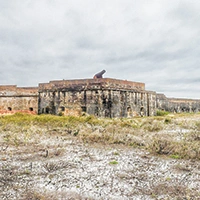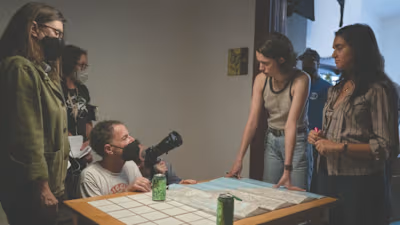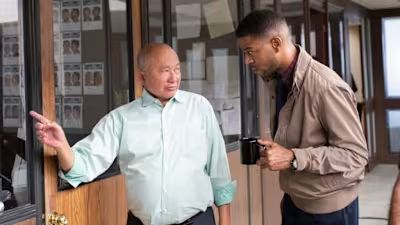Telling a Bigger Story

By Joshua Encinias
If you grew up on the Gulf Coast, chances are you visited Fort Pickens, Fort Barrancas, Santa Rosa Island or Pensacola Pass, whether for a school field trip, a visit to the beach or star gazing with local astronomers. The next time you visit, there’s a new dimension to discover—their roles as sites in the Southern Underground Railroad.
Even locals sometimes assume that in order to travel on the Underground Railroad, escaped slaves would simply go north to the free states.
On March 29, Santa Rosa Island was the fourth site managed by Gulf Islands National Seashore admitted into the National Park Service’s National Underground Railroad Network to Freedom Program. With that fourth designation, park ranger Casimer Rosiecki hopes to show the Gulf Coast that the network of freedom wasn’t only pointed north.
“You could go south to get to places like the British Bahamas,” says Rosiecki. “During the Civil War, if you could get to a U.S. Army camp in Pensacola, the officers in command could save you from your enslaver or other slave catchers.”
One reason why northern cities like Philadelphia, New York City and Boston are more associated with the Underground Railroad has to do with literacy. Abolitionists in those urban areas who knew how to read and write preserved the stories of freedom seekers. In the South, people trying to escape slavery preserved their stories through oral tradition among themselves, but oral histories can be difficult for historians to track down, corroborate and verify.
A new initiative undertaken at the Gulf Islands National Seashore and other national park sites empowers park rangers and park managers to widen the historical lens to tell a fuller story that includes local involvement in abolition. Rosiecki, who moved to the area five years ago, took up the cause by using his time working from home during the pandemic to help declare multiple sites at Gulf Islands as part of the Underground Railroad.
“I have a personal drive to uncover and share more history around the timeframe of the Civil War and early Reconstruction Era,” says Rosiecki, “all in an effort to help myself with my job as a park ranger, but also to help people who come here to get a better understanding of this important history on the Gulf Coast.”
Rosiecki has a lifelong interest in U.S. history, with an emphasis on the mid-19th century. When the pandemic closed Gulf Islands and he transitioned to telework, it gave him the time to research, read and prepare applications so that sites within Gulf Islands could be considered for federal designation in the Underground Railroad Network to Freedom Program.
Pensacola History is National History
Gulf Islands’ four sites included in the network show our area’s history is nationally important.
“It’s a history that belongs to the American people, present and future generations,” says Rosiecki.
National Park Service designations bring prestigious national recognition to Gulf Islands. They also add to our understanding of the Underground Railroad’s history. Inclusion places the four sites in a database managed by the National Park Service Network that allows anyone to learn about Underground Railroad destinations, programs or facilities and visit those places if they are publicly accessible. Rosiecki told us it can help promote tourism and economic development along the coast.
One of the resources Rosiecki used for his research came from University of Houston historian Matthew Clavin, who published the book “Aiming for Pensacola” through the Harvard University Press. The book looks at the Underground Railroad history here in the Pensacola region.
Pensacola’s decades of rule by Spain, Great Britain and the United States left it isolated from antebellum Southern society. As other Gulf Coast seaports like New Orleans developed and flourished based on slavery, Pensacola became an enclave of freedom.
In the book, Clavin wrote, “Pensacola became known for something else—as an enclave of diverse, free peoples of European, African and Native American descent. Farmers, laborers, mechanics, soldiers and sailors learned to cooperate across racial lines and possessed no vested interest in maintaining slavery or white supremacy.”
Our reputation as an easier access point to freedom became known to the enslaved and enslavers “and how it became a beacon for fugitives who found northern routes to liberation inaccessible,” Clavin continued.
Rosiecki says it’s a history that isn’t widely known within the academic world.
“I would even go as far as to say it isn’t widely known along the northern Gulf Coast or even here in West Florida,” he says.
Pensacola’s involvement in slavery wasn’t all positive before abolition, though. In the mid-1820s, the U.S. Navy rented the enslaved to build the Pensacola Navy Yard. “The Army Corps of Engineers also used slave renting to construct the string of Army forts in West Florida,” says Rosiecki.
In a twist of fate, after completion, the forts became Pensacola’s sites where fugitive slaves sought their freedom. They’re the products and consequences of slavery in the United States, but they became tools to dismantle it.
Getting the Word Out
Phase one of Rosiecki’s initiative was made up of researching, writing and editing applications for federal designation. In phase two, he’s moving to share our local Underground Railroad sites and human-interest stories with the public.
For example, there are a few published and unpublished memoirs, diaries and letters from Civil War soldiers who write about enslaved people being present and coming to U.S. military sites in our area.
One of the enslaved was Henry Stalburt, a Union soldier in the 86th United States Colored Troops. His journey to freedom began in August 1863 when he escaped the Burnett plantation in Sparta, Ala. Two weeks later, Stalburt was captured in Pensacola and tortured by Confederate soldiers. When he was returned to the plantation, a tire iron was fit around Henry’s right ankle and formed a hook under his foot.
Despite everything, Stalburt escaped again in November 1863. Miraculously, he made the 100-mile trek to Fort Barrancas, where union soldiers removed the stabbing device from his foot. After, he served in the Union army until 1965 when he left for medical reasons. While in the service, Stalburt helped liberate hundreds of men, women and children through various expeditions.
Rosiecki is working to install outdoor interpretive waysides relevant to his discoveries at the Gulf Islands parks, and he’s working to establish relationships with organizations in the community to share these stories. He also wants to create an in-person, ranger-guided program through Underground Railroad history in the parks.
“I’m hopeful that members of the community will learn about these stories and want to volunteer at Gulf Islands,” says Rosiecki. “As a volunteer, you can work with park rangers to develop programs and lead visitors through these sites and share our Underground Railroad history.”
For volunteer opportunities, you can email the Gulf Island National Seashore at guis_information@nps.gov.
Spread the love
Found in: featured
Found in: Issue
Found in: News
Tags: Underground Railroad,
Like this project
Posted Jan 22, 2024
By Joshua Encinias If you grew up on the Gulf Coast, chances are you visited Fort Pickens, Fort Barrancas, Santa Rosa Island or Pensacola Pass, whether for a s…
Likes
0
Views
6





